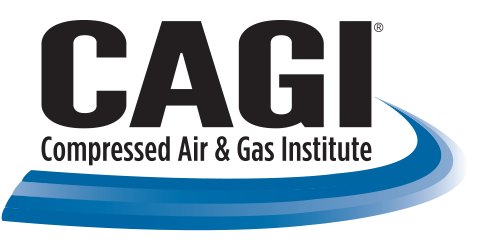
Choose a blower type from the left-hand menu.
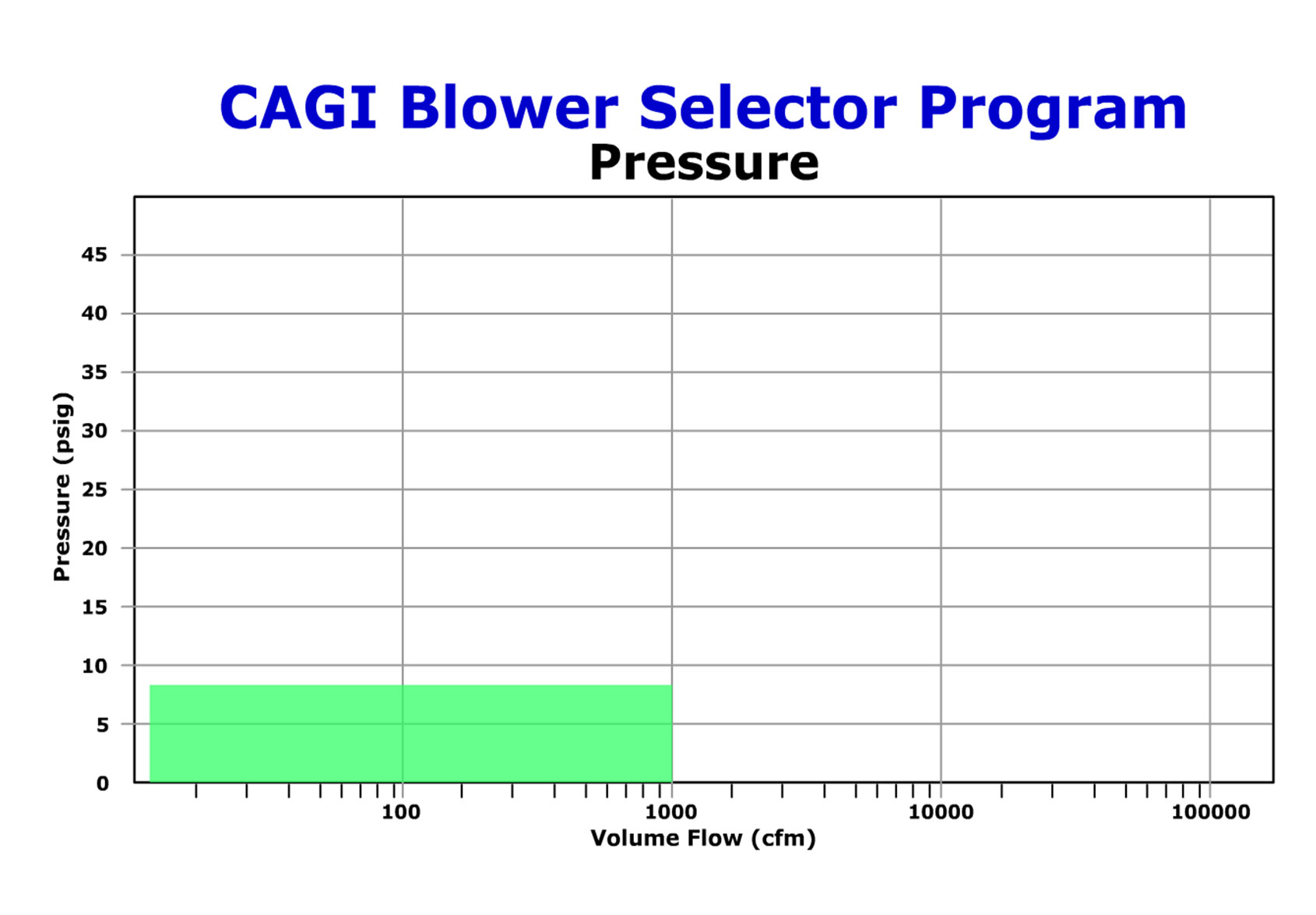
REGENERATIVE BLOWERS
Regenerative blowers are used in applications ranging typically from .5 to 8 psig duty, with flows up to 1000 scfm. This type of blower operates through the use of one or two spinning impellers that contain a series of blades which draw air or other gases into the blower, then, by centrifugal action, accelerate the air outward and forward. The air is turned back by an annular shaped housing to the base of the following blades, where greater pressure is imparted to the air or gas until it is finally diverted out of the blower through the discharge porting. The impeller is non-contacting, providing oil free air or gas.
Advantages of regenerative blowers include their compact size, as motors are typically mounted integrally to the machine. They are relatively quiet in operation as compared to other blower designs, and very cost competitive. They are also less sensitive to ingested solids.
Disadvantages include limitations on pressure and fluxuations of flow and efficiency with changes in pressure, as compared with positive displacement blowers.
Popular applications include:
Companies that manufacture this type of product:
Gardner Denver, Inc.
Howden Spencer
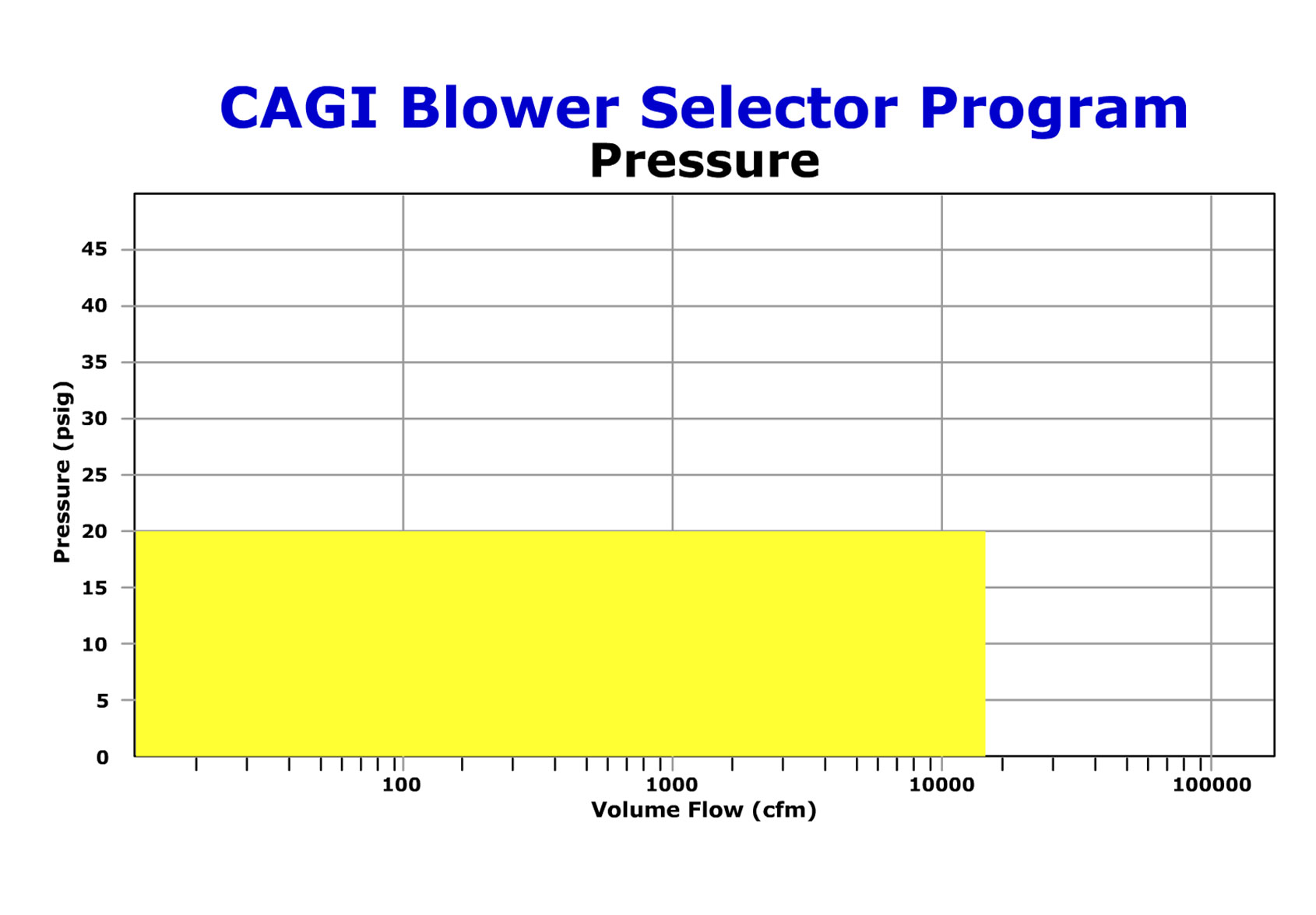
LIQUID RING PUMPS AND COMPRESSORS
Liquid ring pumps and compressors are valveless, oil free, positive displacement machines with a built-in volume ratio that are used for both vacuum and pressure service. The liquid ring machine has a rotor, with several fixed blades (either straight or forward curved), that rotates eccentrically in a cylinder that is normally circular. The clearance between the end of the rotor and the end plates is minimal while the tip clearance between the rotor blades and the cylinder wall varies due to the eccentricity, similar to a sliding vane machine but with a much greater minimum clearance. The cylinder is partially filled with water or other low viscosity liquid. During operation, the liquid is carried around the cylinder by the action of the rotor blades. Due to centrifugal force, the liquid forms a solid ring around the inside of the cylinder. The rotor blades vary in the distance they are immersed in the liquid due to the rotor's eccentric location. The liquid ring seals each cell from the next and the volume of the cells decrease as the rotor rotates, compressing the gas until it is finally displaced through the discharge port.
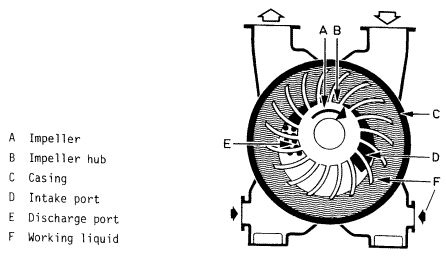
Figure 1
Liquid Ring Pump
The liquid is heated by the compressed gas and the influence of liquid friction. The fluid then must be continuously replaced with cold fluid. The cooling of the gas is direct, (due to the mixing of the liquid and the gas). Because of the intimate contact between the gas and the liquid, the final discharge temperature can be held close to the liquid inlet temperature. The discharge gas will be saturated at the temperature of the compressing liquid.
The liquid is usually water, but other liquids may be chosen for other
desired results during the compression process, such as the absorption
of a constituent of the gas by the liquid, or as a means of protecting
the compressor from corrosive attack by chemically aggressive gases
and vapors. In principle, the compression is isothermal, but due to
the friction of the liquid against the casing and the churning losses
due the vanes dipping into and out of the liquid, there is an additional
loss.
Disadvantages of liquid ring compressors are their higher power consumption,
the large quantity of cooling water needed and in some cases the necessity
for manufacturing the main parts of the machine of metals resistant
to corrosion caused by the sealing liquid. They do have some valuable
operational properties so that they are used mainly in severe operating
conditions. They are extremely simple. Wear due to friction occurs only
in the bearings. The air delivered is cool, free of dust and oil, and
can therefore be used directly for clarification, agitation and repumping
of liquids in the chemical and food industries without the need for
coolers or filters in the delivery line. In addition to this, the absolute
humidity of the delivered air is fairly low due to the low compression
temperatures.
The maximum pressure reached with these compressors as single-stage machines is about 35 psig and 22 in-Hg in vacuum service. They are built for capacities of from 7 cfm to 12000 cfm. The speed of the smallest machines is 3500 rpm and that of the largest 250 rpm. One major positive attribute of the machine is its low sound level.
Companies that manufacture this type or product:
Gardner Denver, Inc.
MD-Kinney
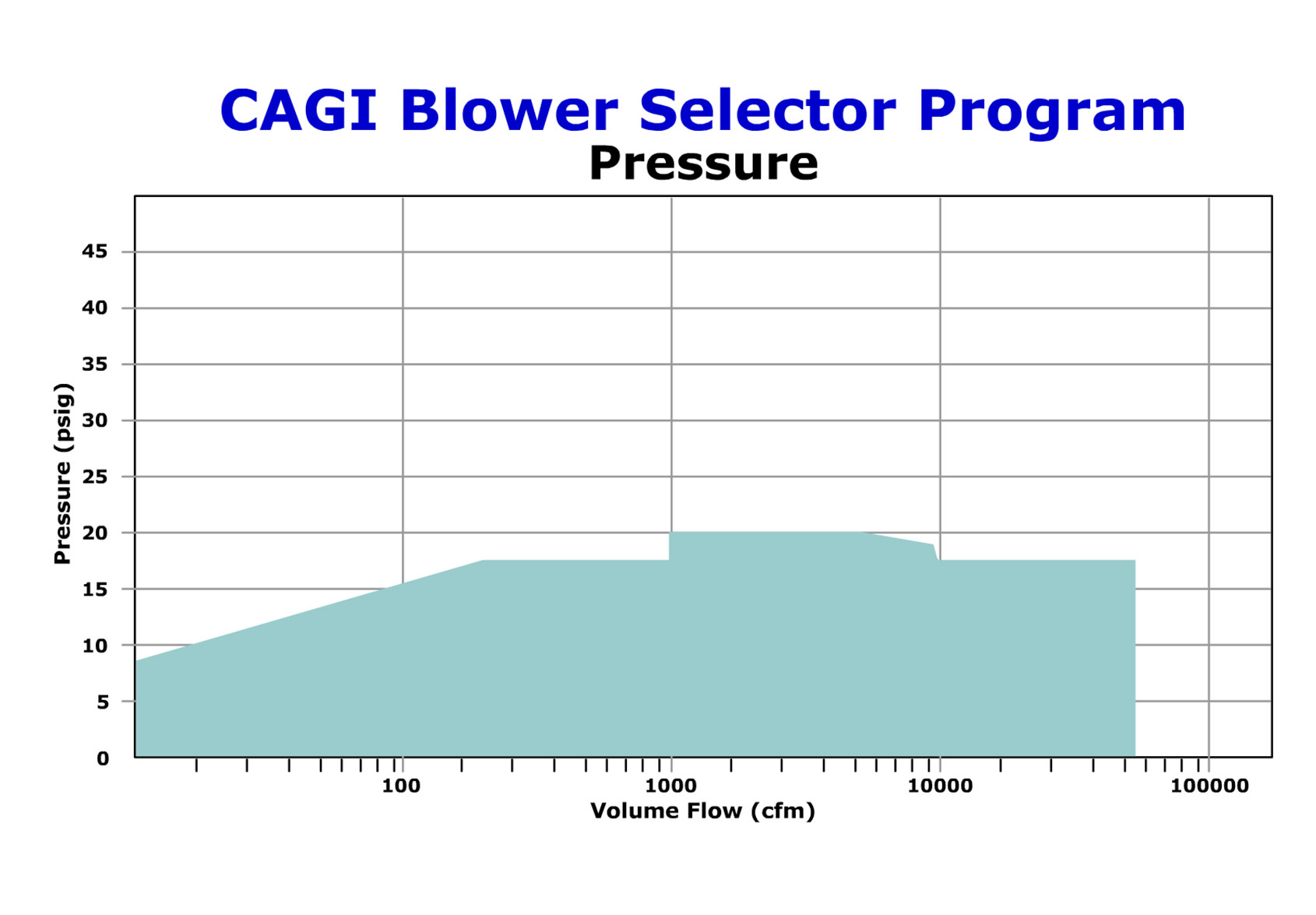
ROTARY LOBE POSITIVE DISPLACEMENT BLOWERS
Rotary lobe blowers are positive displacement machines, commonly used for handling air or other gases up to 2 to 1 compression ratios, for either pressure or vacuum duty. These machines consist of two precision machined impellers (rotors) which rotate opposite to one another, within an enclosed cylinder comprised of the housing (casing) and endplates. As each impeller passes the inlet opening of the housing, it traps a positive volume of air or gas, and carries it around the housing to the discharge opening, where it is expelled. The impellers are non-contracting, operating with minute clearances between themselves through the use of precision timing gears. In addition, clearances between the impellers, housing, and endplates are held to very low values to minimize "back slipping" of the discharge gas to the inlet side, to optimize efficiency. As the rotating parts are non contacting, rotary blowers operate dry, without the need for a sealing fluid or lubricant within the process chamber. The impellers are commonly either two lobe, or figure eight shaped, or three lobe. Rotary blowers with two lobe impellers expel four pockets of air or gas per revolution, while units with three lobe impellers expel six pockets of air or gas.
Benefits oft this type of equipment include minor variations in flow compared to changes in differential pressure or vacuum, good reliability, and competitive cost. Typical operating ranges are from 2 to 15 psig under pressure duty, though designs are available to 20 psig. In addition, units can be multi-staged for duty as high as 40 psig with interstage cooling. Vacuums to 15 inches Hg are typical, though models are available at higher levels, both dry and liquid injected. Variations in internal seal designs are available for use in non air service, where leak tight operation is essential.
Disadvantages include the fact that rotary blowers are characteristically noisy, though there are designs available with reduced noise levels. In addition, these machines are not overly forgiving in terms of handling solids such as dust or contaminants, due to the small internal clearances between the rotating parts.
Rotary lobe blowers are used in a wide variety of applications. Popular services include the following:
Companies that manufacture this type of product:
Eurus Blower, Inc.
Gardner Denver, Inc.
Howden Roots
Kaeser Compressors
MD-Kinney
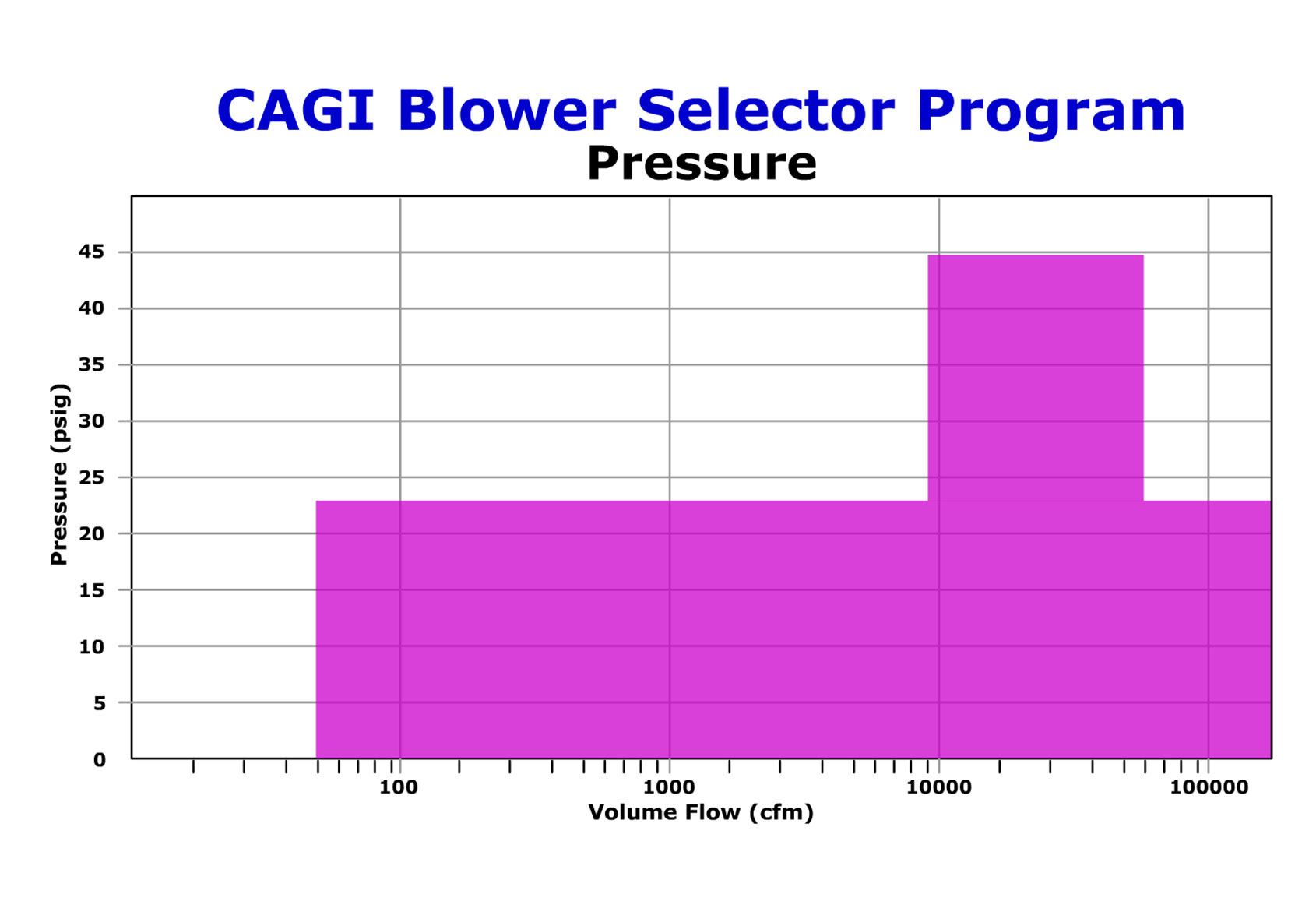
MULTI STAGE CENTRIFUGAL COMPRESSORS
Multi stage blowers come in two basic designs: vertically split and horizontally split. Both designs are used in many ways in industry to compress a wide variety of gases including air through multiple stages of compression. These are dynamic machines that allow the user to vary the gas flow through a throttling device at a constant speed. The basic design differences are outlined below:
Horizontally split - This style machine is split on a horizontal plane through the center line of the shaft with inlet and discharge connections cast integrally with the casing. The user often times has the flexibility to specify that the discharge and inlet connections be in the top half casing or the bottom half casing or one in the top half and one in the bottom half. Removal of the top half of the casing permits complete access for inspection or removal of the rotor and casing diaphragms. In addition, the bearing housings are also horizontally split allowing for complete access to the bearings without disturbing the process piping. These machines are pressure lubricated as a standard and come with a number of seal options to meet the customer’s specification. The lubrication system can be integral or console type built to API standards. Flow control may be accomplished by suction throttling, inlet guide vanes or speed variation, each having their own advantages weighing initial cost versus efficiency gains and control complexity.
Vertically split - This style machine is of a modular design with the case vertically split to facilitate changing the number of compression stages to meet the operating requirements. The inlet and discharge locations can be located in a number of combinations to meet the customer needs. Standard offerings for this style machines are anti-friction bearings with splash lubrication, although other options are available depending on the manufacturer. Flow control may be accomplished by suction throttling and/or speed variation again with each having its advantages of initial cost versus efficiency gains and control complexity.
Manufacturers of these blowers offer a complete range of control and monitoring packages to meet the customer system needs as well as health monitoring of the blower package.
Companies that manufacture this type of product:
Atlas Copco Compressors
Eurus Blower, Inc.
Gardner Denver, Inc.
Howden Roots
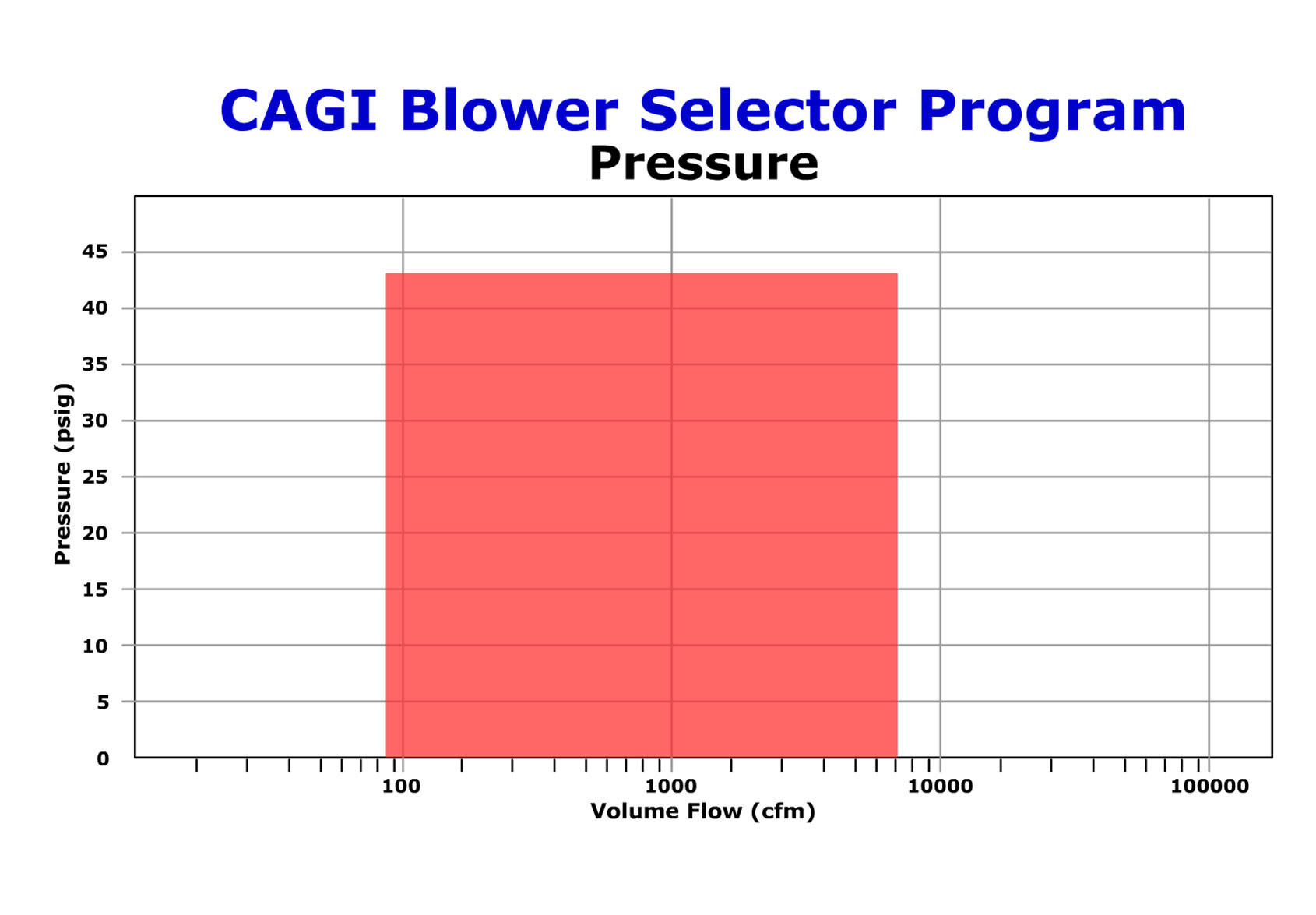
HELICAL SCREW POSITIVE DISPLACEMENT BLOWERS
This machine has two rotors compressing the gas between the intermeshing helical rotors and the discharge end of the housing. The profile of the lobes on the two rotors are not identical. The male rotor ( main rotor ) has a form that fits into the pocket ( flute ) of the female rotor ( gate rotor ). These blowers require timing gears to maintain close rotor clearances and to prevent contact between the rotors. The helical twist in the rotors and the pocket location, with rotation, in respect to the inlet and discharge ports of the housing causes internal compression.
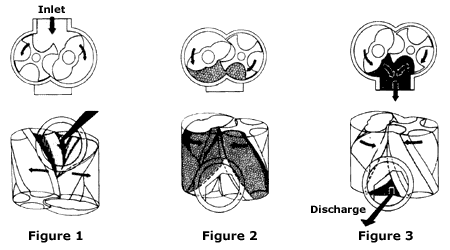
Figure 1. The compression cycle begins as the rotors unmesh at the
inlet port.
Figure 2. As the rotor tips pass the inlet cutoff point, the gas is
captured between the pocket of the gate rotor and the housing bore and
also between the pocket of the main rotor and the housing bore. As rotation
continues, these pockets join together and the gas moves axially towards
the discharge port and is compressed as the joined pocket begins to
shorten.
Figure 3. When the joined pocket reaches the discharge port, the compressed
gas is discharged.
While this is happening with one combination of rotor pockets, the
same cycle is happening in the other pockets. With the two lobe main
rotor and four flute gate rotor, the compression cycle occurs twice
for each revolution of the main rotor and is continuous.
The gas is oil-free since no lubrication is required in the housing
and sealing is done with close clearances.
Other positive displacement blowers with helical rotors use a flood of oil through the rotors to seal the clearance gaps and to cool the compressed gas. They typically operate at higher pressures and by the use of special profile rotors do not require timing gears as one rotor drives the other.
Companies that manufacture this type of product:
Atlas Copco Compressors
Gardner Denver, Inc.
Kaeser Compressors
MD-Kinney
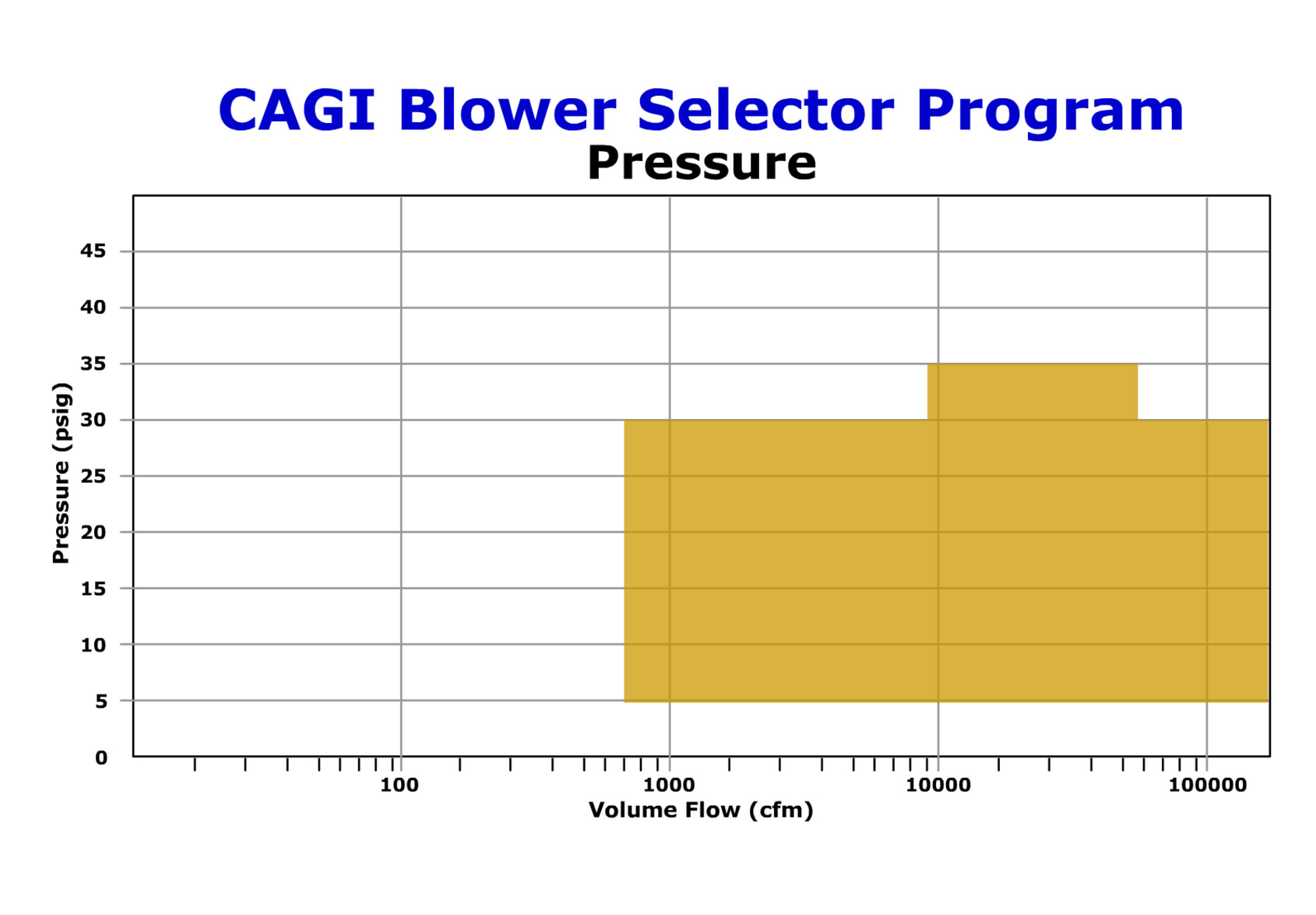
SINGLE STAGE CENTRIFUGAL COMPRESSORS
Single stage centrifugal compressors are variable flow machines commonly used for movement of air or other gases up to a 3 to 1 compression ratio for either pressure or vacuum duty. These machines consist of a single rotating impeller mounted within a casing which defines the gas inlet flow path, diffuser section, and discharge volute or collector area. The compression ratio capability of the compressor is primarily a function of the impeller peripheral speed and blade geometry. Impeller materials vary from aluminum, steel, and stainless steel depending on gas properties and rotational speed. Variations in shaft seal designs are available to suit gas being compressed.
Flow control may be accomplished by suction throttling, inlet guide vanes, discharge diffuser vanes, or speed variation. Each have their own advantages weighing initial cost against efficiency gains and control complexity.
Benefits of the single stage centrifugal compressor include high efficiency over a wide operation range. Delivered flow (and power consumption) can be reduced by nearly 50% without use of recycle or blow off lines. Delivered gas is oil and pulsation free.
Single stage centrifugal compressors are built for flow capacities ranging from 1,000 cfm up to 300,000 cfm. Initial cost of the low capacity machines may be higher than positive displacement type machines. However, in the medium to high capacity range, initial cost is generally very attractive.
Companies that manufacture this type of product:
Atlas Copco Compressors
Gardner Denver, Inc.
Kaeser Compressors
Howden Roots
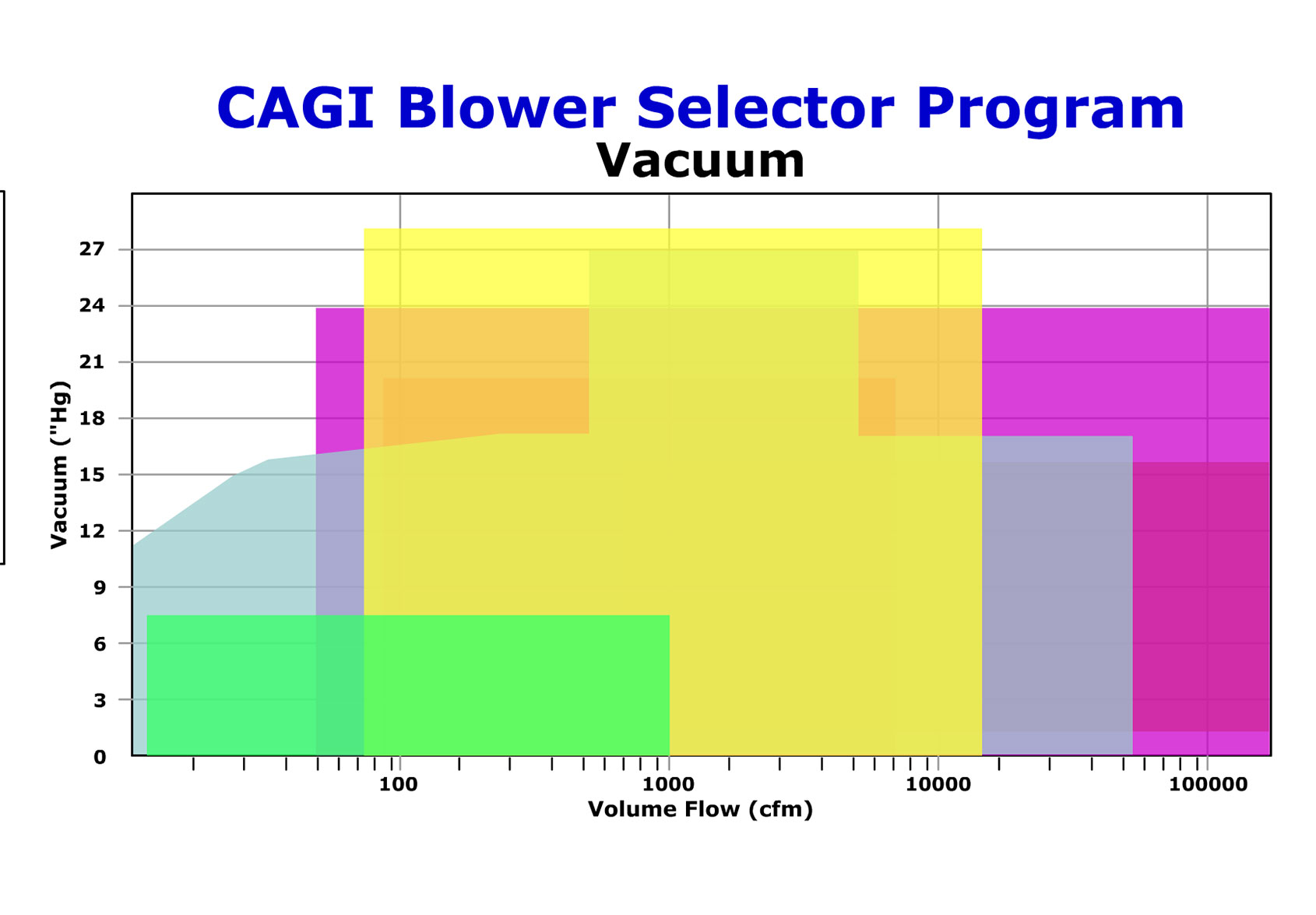
Choose a blower type from the left-hand menu.
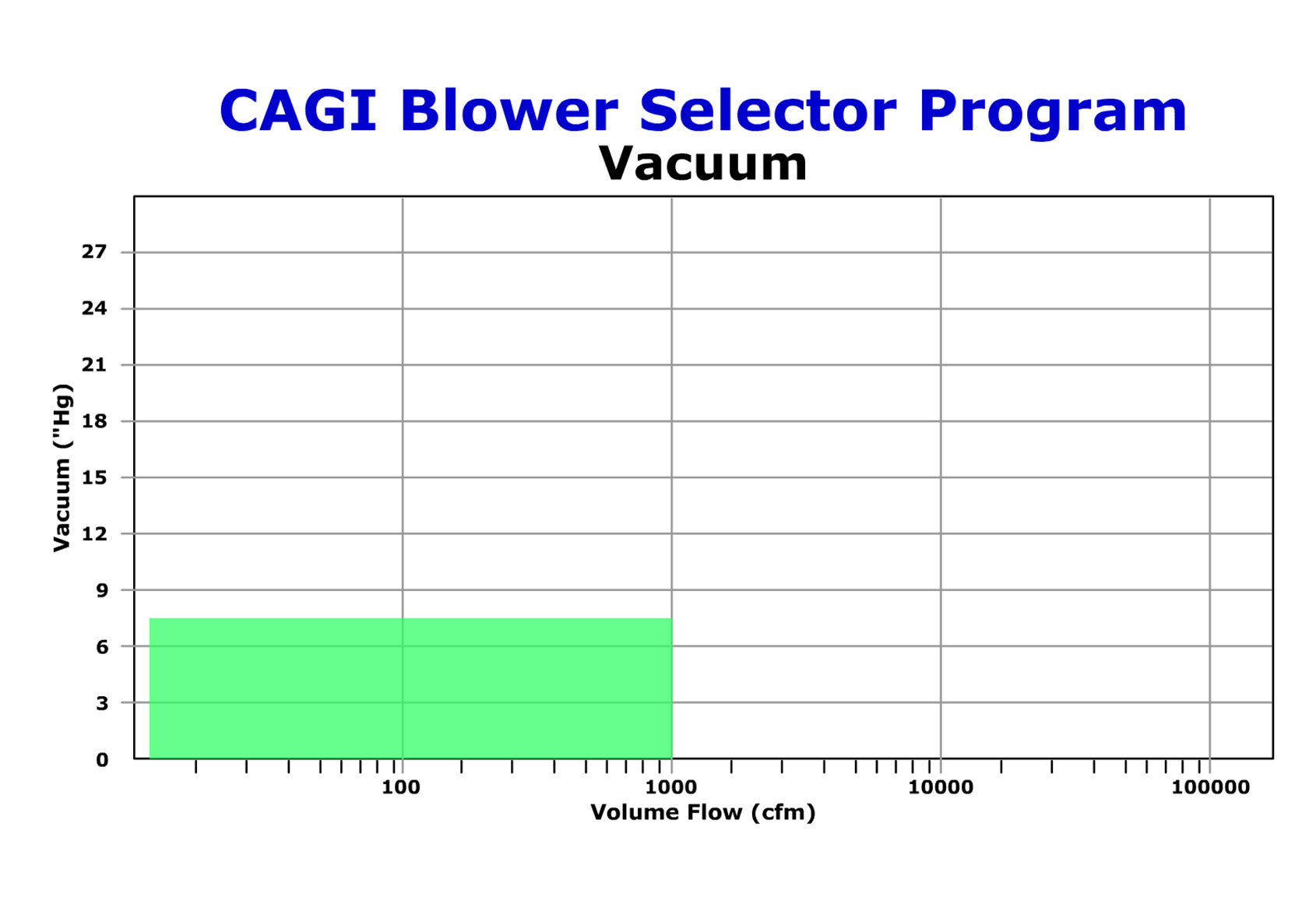
REGENERATIVE BLOWERS
Regenerative blowers are used in applications ranging typically from .5 to 8 psig duty, with flows up to 1000 scfm. This type of blower operates through the use of one or two spinning impellers that contain a series of blades which draw air or other gases into the blower, then, by centrifugal action, accelerate the air outward and forward. The air is turned back by an annular shaped housing to the base of the following blades, where greater pressure is imparted to the air or gas until it is finally diverted out of the blower through the discharge porting. The impeller is non-contacting, providing oil free air or gas.
Advantages of regenerative blowers include their compact size, as motors are typically mounted integrally to the machine. They are relatively quiet in operation as compared to other blower designs, and very cost competitive. They are also less sensitive to ingested solids.
Disadvantages include limitations on pressure and fluxuations of flow and efficiency with changes in pressure, as compared with positive displacement blowers.
Popular applications include:
Companies that manufacture this type of product:
Gardner Denver, Inc.
Howden Spencer
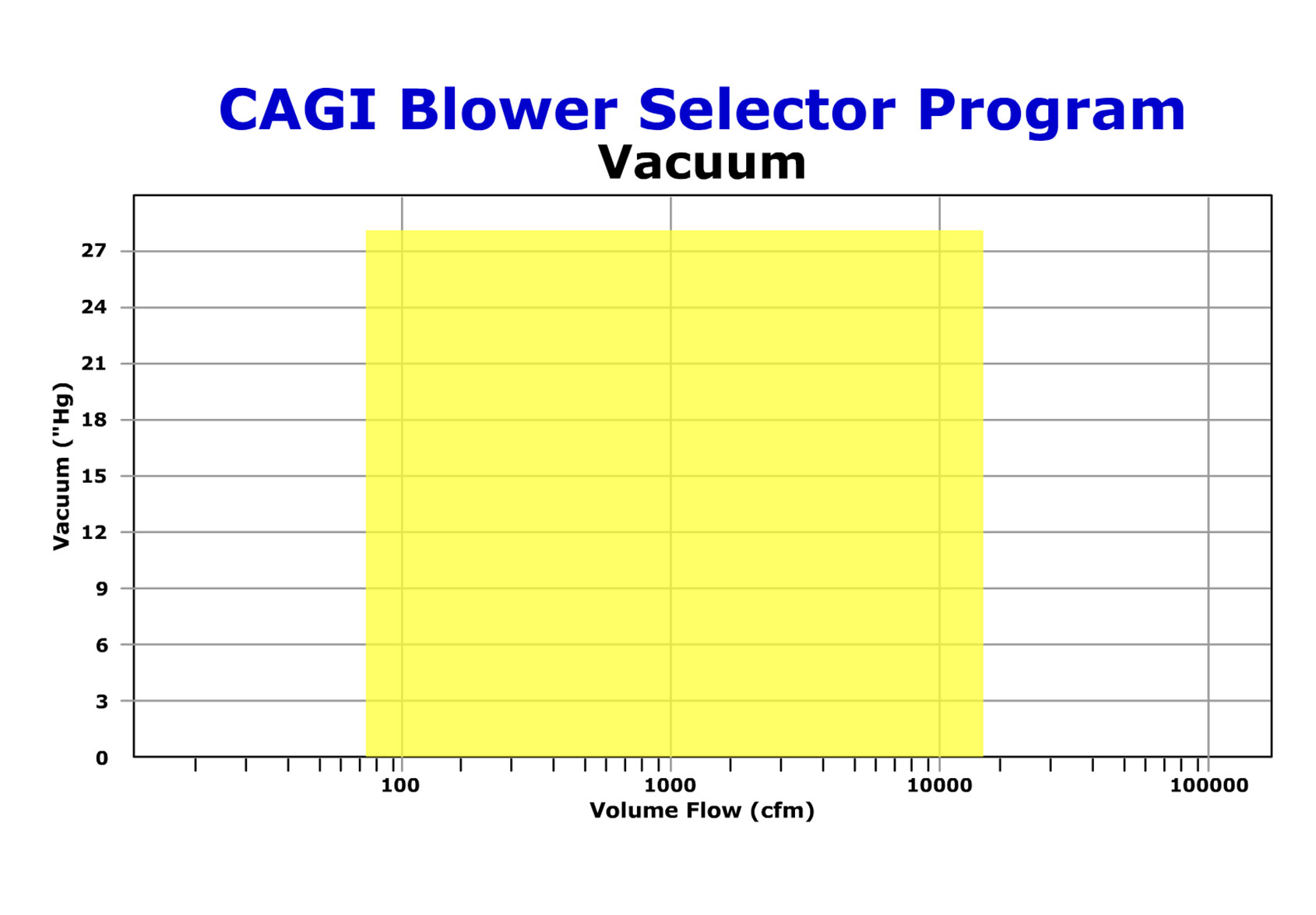
LIQUID RING PUMPS AND COMPRESSORS
Liquid ring pumps and compressors are valveless, oil free, positive displacement machines with a built-in volume ratio that are used for both vacuum and pressure service. The liquid ring machine has a rotor, with several fixed blades (either straight or forward curved), that rotates eccentrically in a cylinder that is normally circular. The clearance between the end of the rotor and the end plates is minimal while the tip clearance between the rotor blades and the cylinder wall varies due to the eccentricity, similar to a sliding vane machine but with a much greater minimum clearance. The cylinder is partially filled with water or other low viscosity liquid. During operation, the liquid is carried around the cylinder by the action of the rotor blades. Due to centrifugal force, the liquid forms a solid ring around the inside of the cylinder. The rotor blades vary in the distance they are immersed in the liquid due to the rotor's eccentric location. The liquid ring seals each cell from the next and the volume of the cells decrease as the rotor rotates, compressing the gas until it is finally displaced through the discharge port.

Figure 1
Liquid Ring Pump
The liquid is heated by the compressed gas and the influence of liquid friction. The fluid then must be continuously replaced with cold fluid. The cooling of the gas is direct, (due to the mixing of the liquid and the gas). Because of the intimate contact between the gas and the liquid, the final discharge temperature can be held close to the liquid inlet temperature. The discharge gas will be saturated at the temperature of the compressing liquid.
The liquid is usually water, but other liquids may be chosen for other
desired results during the compression process, such as the absorption
of a constituent of the gas by the liquid, or as a means of protecting
the compressor from corrosive attack by chemically aggressive gases
and vapors. In principle, the compression is isothermal, but due to
the friction of the liquid against the casing and the churning losses
due the vanes dipping into and out of the liquid, there is an additional
loss.
Disadvantages of liquid ring compressors are their higher power consumption,
the large quantity of cooling water needed and in some cases the necessity
for manufacturing the main parts of the machine of metals resistant
to corrosion caused by the sealing liquid. They do have some valuable
operational properties so that they are used mainly in severe operating
conditions. They are extremely simple. Wear due to friction occurs only
in the bearings. The air delivered is cool, free of dust and oil, and
can therefore be used directly for clarification, agitation and repumping
of liquids in the chemical and food industries without the need for
coolers or filters in the delivery line. In addition to this, the absolute
humidity of the delivered air is fairly low due to the low compression
temperatures.
The maximum pressure reached with these compressors as single-stage machines is about 35 psig and 22 in-Hg in vacuum service. They are built for capacities of from 7 cfm to 12000 cfm. The speed of the smallest machines is 3500 rpm and that of the largest 250 rpm. One major positive attribute of the machine is its low sound level.
Companies that manufacture this type or product:
Gardner Denver, Inc.
MD-Kinney
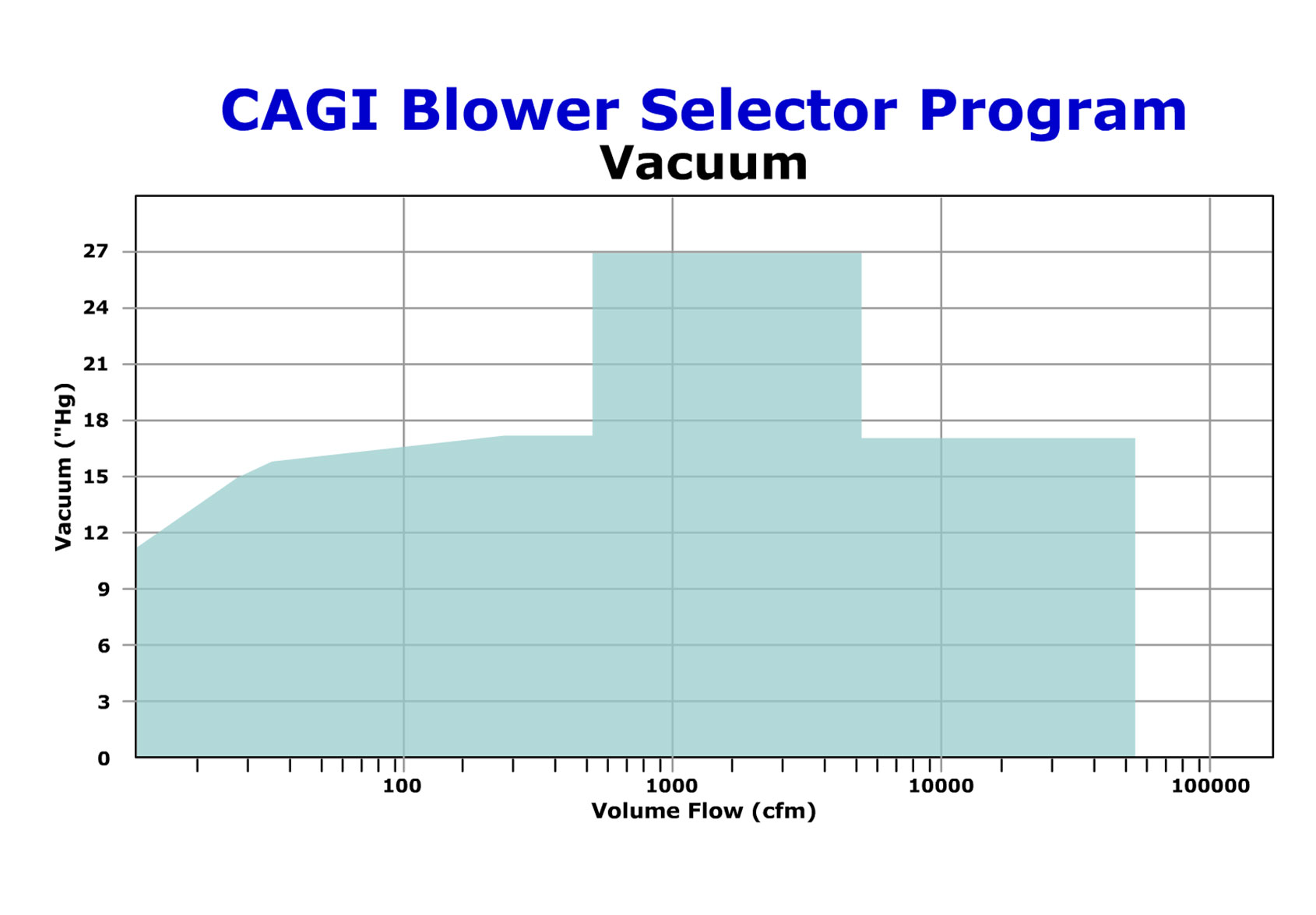
ROTARY LOBE POSITIVE DISPLACEMENT BLOWERS
Rotary lobe blowers are positive displacement machines, commonly used for handling air or other gases up to 2 to 1 compression ratios, for either pressure or vacuum duty. These machines consist of two precision machined impellers (rotors) which rotate opposite to one another, within an enclosed cylinder comprised of the housing (casing) and endplates. As each impeller passes the inlet opening of the housing, it traps a positive volume of air or gas, and carries it around the housing to the discharge opening, where it is expelled. The impellers are non-contracting, operating with minute clearances between themselves through the use of precision timing gears. In addition, clearances between the impellers, housing, and endplates are held to very low values to minimize "back slipping" of the discharge gas to the inlet side, to optimize efficiency. As the rotating parts are non contacting, rotary blowers operate dry, without the need for a sealing fluid or lubricant within the process chamber. The impellers are commonly either two lobe, or figure eight shaped, or three lobe. Rotary blowers with two lobe impellers expel four pockets of air or gas per revolution, while units with three lobe impellers expel six pockets of air or gas.
Benefits oft this type of equipment include minor variations in flow compared to changes in differential pressure or vacuum, good reliability, and competitive cost. Typical operating ranges are from 2 to 15 psig under pressure duty, though designs are available to 20 psig. In addition, units can be multi-staged for duty as high as 40 psig with interstage cooling. Vacuums to 15 inches Hg are typical, though models are available at higher levels, both dry and liquid injected. Variations in internal seal designs are available for use in non air service, where leak tight operation is essential.
Disadvantages include the fact that rotary blowers are characteristically noisy, though there are designs available with reduced noise levels. In addition, these machines are not overly forgiving in terms of handling solids such as dust or contaminants, due to the small internal clearances between the rotating parts.
Rotary lobe blowers are used in a wide variety of applications. Popular services include the following:
Companies that manufacture this type of product:
Eurus Blower, Inc.
Gardner Denver, Inc.
Howden Roots
Kaeser Compressors
MD-Kinney
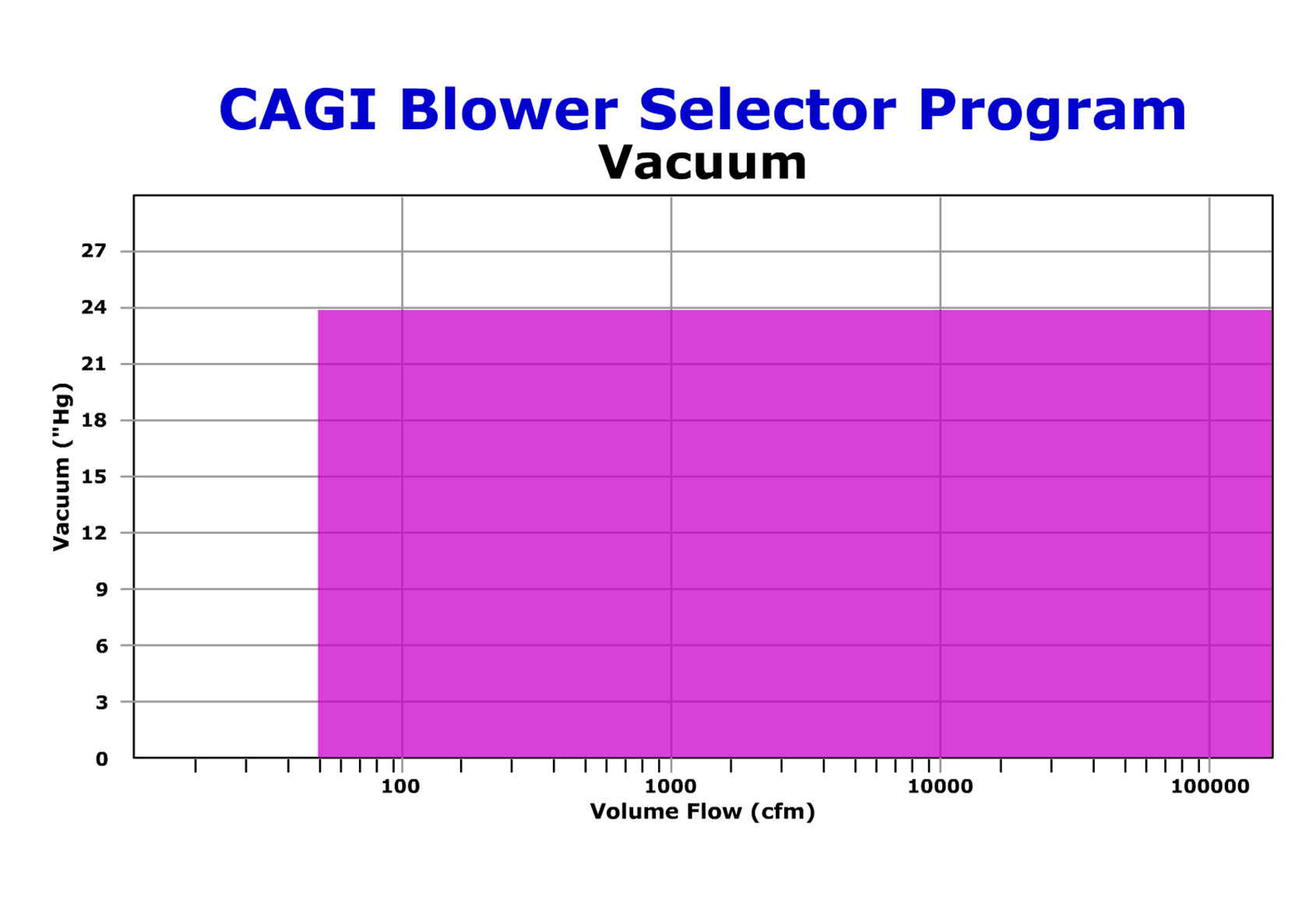
MULTI STAGE CENTRIFUGAL COMPRESSORS
Multi stage blowers come in two basic designs: vertically split and horizontally split. Both designs are used in many ways in industry to compress a wide variety of gases including air through multiple stages of compression. These are dynamic machines that allow the user to vary the gas flow through a throttling device at a constant speed. The basic design differences are outlined below:
Horizontally split - This style machine is split on a horizontal plane through the center line of the shaft with inlet and discharge connections cast integrally with the casing. The user often times has the flexibility to specify that the discharge and inlet connections be in the top half casing or the bottom half casing or one in the top half and one in the bottom half. Removal of the top half of the casing permits complete access for inspection or removal of the rotor and casing diaphragms. In addition, the bearing housings are also horizontally split allowing for complete access to the bearings without disturbing the process piping. These machines are pressure lubricated as a standard and come with a number of seal options to meet the customer’s specification. The lubrication system can be integral or console type built to API standards. Flow control may be accomplished by suction throttling, inlet guide vanes or speed variation, each having their own advantages weighing initial cost versus efficiency gains and control complexity.
Vertically split - This style machine is of a modular design with the case vertically split to facilitate changing the number of compression stages to meet the operating requirements. The inlet and discharge locations can be located in a number of combinations to meet the customer needs. Standard offerings for this style machines are anti-friction bearings with splash lubrication, although other options are available depending on the manufacturer. Flow control may be accomplished by suction throttling and/or speed variation again with each having its advantages of initial cost versus efficiency gains and control complexity.
Manufacturers of these blowers offer a complete range of control and monitoring packages to meet the customer system needs as well as health monitoring of the blower package.
Companies that manufacture this type of product:
Atlas Copco Compressors
Eurus Blower, Inc.
Gardner Denver, Inc.
Howden Roots
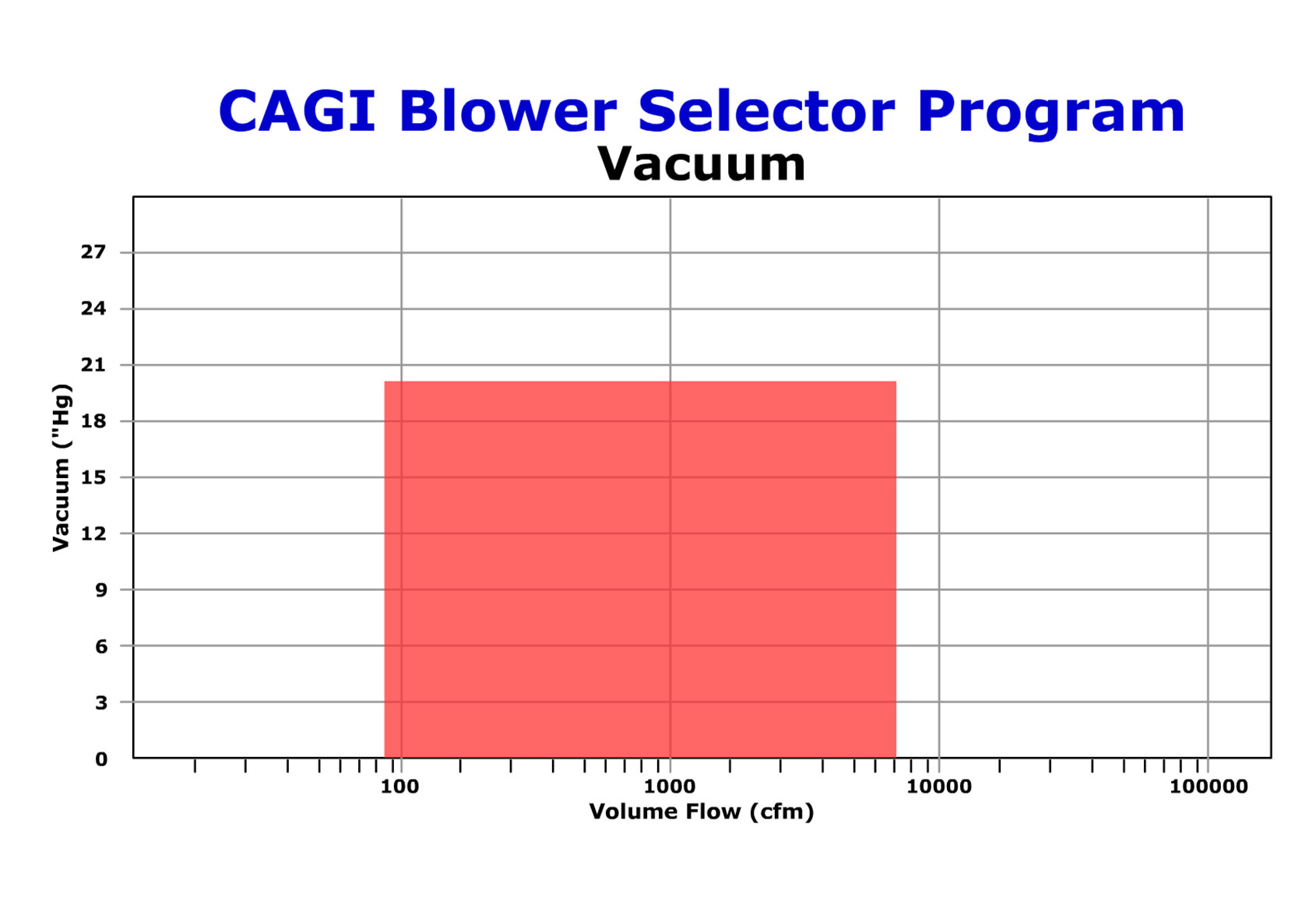
HELICAL SCREW POSITIVE DISPLACEMENT BLOWERS
This machine has two rotors compressing the gas between the intermeshing helical rotors and the discharge end of the housing. The profile of the lobes on the two rotors are not identical. The male rotor ( main rotor ) has a form that fits into the pocket ( flute ) of the female rotor ( gate rotor ). These blowers require timing gears to maintain close rotor clearances and to prevent contact between the rotors. The helical twist in the rotors and the pocket location, with rotation, in respect to the inlet and discharge ports of the housing causes internal compression.

Figure 1. The compression cycle begins as the rotors unmesh at the
inlet port.
Figure 2. As the rotor tips pass the inlet cutoff point, the gas is
captured between the pocket of the gate rotor and the housing bore and
also between the pocket of the main rotor and the housing bore. As rotation
continues, these pockets join together and the gas moves axially towards
the discharge port and is compressed as the joined pocket begins to
shorten.
Figure 3. When the joined pocket reaches the discharge port, the compressed
gas is discharged.
While this is happening with one combination of rotor pockets, the
same cycle is happening in the other pockets. With the two lobe main
rotor and four flute gate rotor, the compression cycle occurs twice
for each revolution of the main rotor and is continuous.
The gas is oil-free since no lubrication is required in the housing
and sealing is done with close clearances.
Other positive displacement blowers with helical rotors use a flood of oil through the rotors to seal the clearance gaps and to cool the compressed gas. They typically operate at higher pressures and by the use of special profile rotors do not require timing gears as one rotor drives the other.
Companies that manufacture this type of product:
Atlas Copco Compressors
Gardner Denver, Inc.
Kaeser Compressors
MD-Kinney
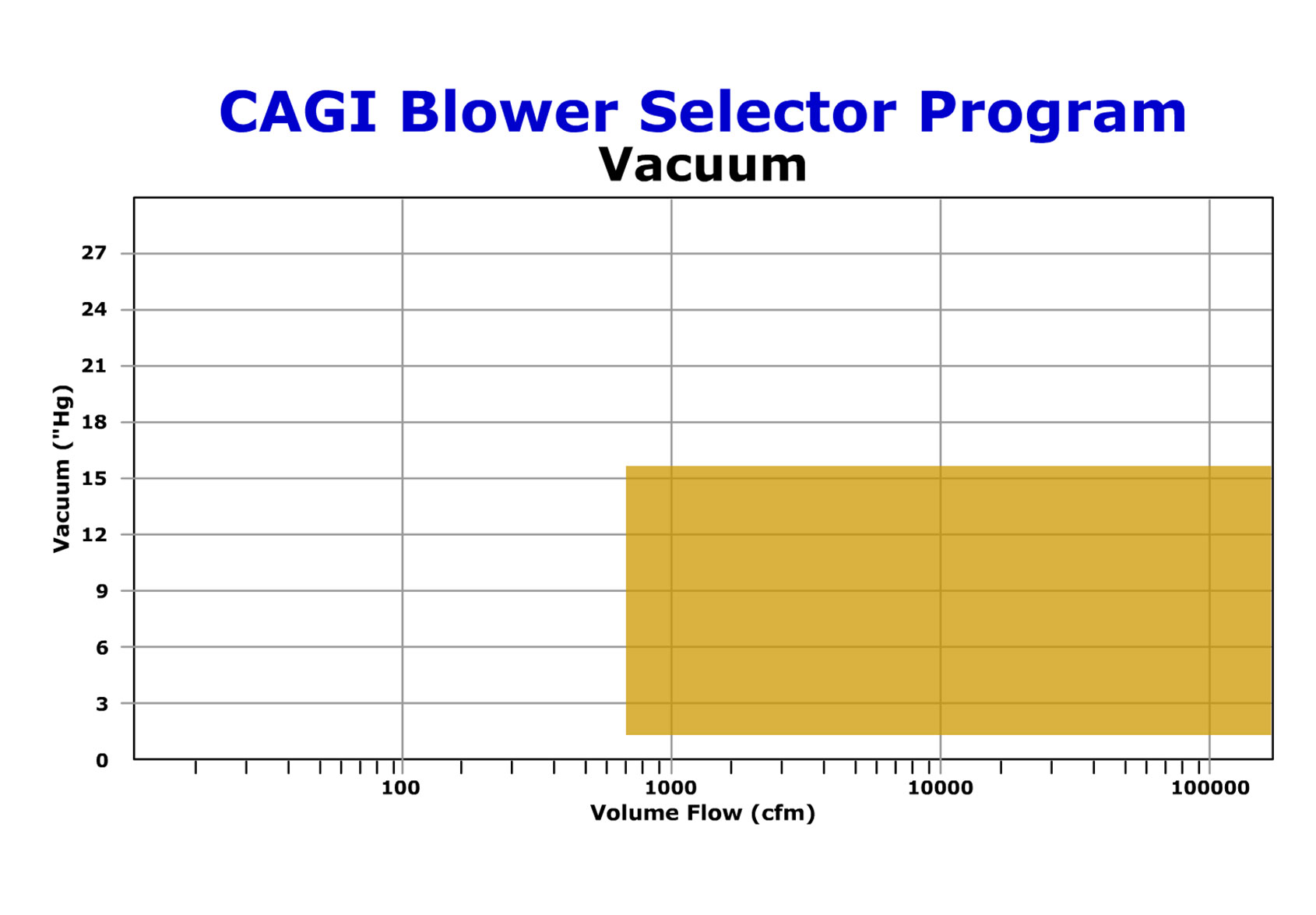
SINGLE STAGE CENTRIFUGAL COMPRESSORS
Single stage centrifugal compressors are variable flow machines commonly used for movement of air or other gases up to a 3 to 1 compression ratio for either pressure or vacuum duty. These machines consist of a single rotating impeller mounted within a casing which defines the gas inlet flow path, diffuser section, and discharge volute or collector area. The compression ratio capability of the compressor is primarily a function of the impeller peripheral speed and blade geometry. Impeller materials vary from aluminum, steel, and stainless steel depending on gas properties and rotational speed. Variations in shaft seal designs are available to suit gas being compressed.
Flow control may be accomplished by suction throttling, inlet guide vanes, discharge diffuser vanes, or speed variation. Each have their own advantages weighing initial cost against efficiency gains and control complexity.
Benefits of the single stage centrifugal compressor include high efficiency over a wide operation range. Delivered flow (and power consumption) can be reduced by nearly 50% without use of recycle or blow off lines. Delivered gas is oil and pulsation free.
Single stage centrifugal compressors are built for flow capacities ranging from 1,000 cfm up to 300,000 cfm. Initial cost of the low capacity machines may be higher than positive displacement type machines. However, in the medium to high capacity range, initial cost is generally very attractive.
Companies that manufacture this type of product:
Atlas Copco Compressors
Gardner Denver, Inc.
Howden Roots
Compressed Air & Gas Institute
1300 Sumner Avenue
Cleveland, OH 44115
Phone: 216/241-7333
Fax: 216/241-0105
©2025 CAGI
